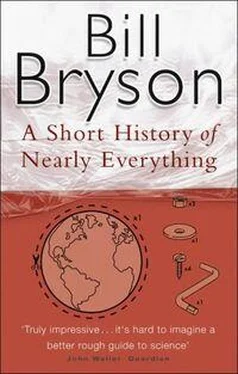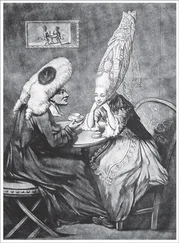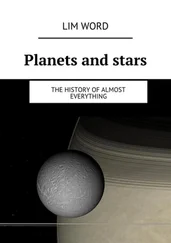Extrapolating from his Schiehallion measurements, Hutton calculated the mass of the Earth at 5,000 million million tons, from which could reasonably be deduced the masses of all the other major bodies in the solar system, including the Sun. So from this one experiment we learned the masses of the Earth, the Sun, the Moon, the other planets and their moons, and got contour lines into the bargain-not bad for a summer’s work.
Not everyone was satisfied with the results, however. The shortcoming of the Schiehallion experiment was that it was not possible to get a truly accurate figure without knowing the actual density of the mountain. For convenience, Hutton had assumed that the mountain had the same density as ordinary stone, about 2.5 times that of water, but this was little more than an educated guess.
One improbable-seeming person who turned his mind to the matter was a country parson named John Michell, who resided in the lonely Yorkshire village of Thornhill. Despite his remote and comparatively humble situation, Michell was one of the great scientific thinkers of the eighteenth century and much esteemed for it.
Among a great deal else, he perceived the wavelike nature of earthquakes, conducted much original research into magnetism and gravity, and, quite extraordinarily, envisioned the possibility of black holes two hundred years before anyone else-a leap of intuitive deduction that not even Newton could make. When the German-born musician William Herschel decided his real interest in life was astronomy, it was Michell to whom he turned for instruction in making telescopes, a kindness for which planetary science has been in his debt ever since. [6]
But of all that Michell accomplished, nothing was more ingenious or had greater impact than a machine he designed and built for measuring the mass of the Earth. Unfortunately, he died before he could conduct the experiments and both the idea and the necessary equipment were passed on to a brilliant but magnificently retiring London scientist named Henry Cavendish.
Cavendish is a book in himself. Born into a life of sumptuous privilege-his grandfathers were dukes, respectively, of Devonshire and Kent-he was the most gifted English scientist of his age, but also the strangest. He suffered, in the words of one of his few biographers, from shyness to a “degree bordering on disease.” Any human contact was for him a source of the deepest discomfort.
Once he opened his door to find an Austrian admirer, freshly arrived from Vienna, on the front step. Excitedly the Austrian began to babble out praise. For a few moments Cavendish received the compliments as if they were blows from a blunt object and then, unable to take any more, fled down the path and out the gate, leaving the front door wide open. It was some hours before he could be coaxed back to the property. Even his housekeeper communicated with him by letter.
Although he did sometimes venture into society-he was particularly devoted to the weekly scientific soirées of the great naturalist Sir Joseph Banks-it was always made clear to the other guests that Cavendish was on no account to be approached or even looked at. Those who sought his views were advised to wander into his vicinity as if by accident and to “talk as it were into vacancy.” If their remarks were scientifically worthy they might receive a mumbled reply, but more often than not they would hear a peeved squeak (his voice appears to have been high pitched) and turn to find an actual vacancy and the sight of Cavendish fleeing for a more peaceful corner.
His wealth and solitary inclinations allowed him to turn his house in Clapham into a large laboratory where he could range undisturbed through every corner of the physical sciences-electricity, heat, gravity, gases, anything to do with the composition of matter. The second half of the eighteenth century was a time when people of a scientific bent grew intensely interested in the physical properties of fundamental things-gases and electricity in particular-and began seeing what they could do with them, often with more enthusiasm than sense. In America, Benjamin Franklin famously risked his life by flying a kite in an electrical storm. In France, a chemist named Pilatre de Rozier tested the flammability of hydrogen by gulping a mouthful and blowing across an open flame, proving at a stroke that hydrogen is indeed explosively combustible and that eyebrows are not necessarily a permanent feature of one’s face. Cavendish, for his part, conducted experiments in which he subjected himself to graduated jolts of electrical current, diligently noting the increasing levels of agony until he could keep hold of his quill, and sometimes his consciousness, no longer.
In the course of a long life Cavendish made a string of signal discoveries-among much else he was the first person to isolate hydrogen and the first to combine hydrogen and oxygen to form water-but almost nothing he did was entirely divorced from strangeness. To the continuing exasperation of his fellow scientists, he often alluded in published work to the results of contingent experiments that he had not told anyone about. In his secretiveness he didn’t merely resemble Newton, but actively exceeded him. His experiments with electrical conductivity were a century ahead of their time, but unfortunately remained undiscovered until that century had passed. Indeed the greater part of what he did wasn’t known until the late nineteenth century when the Cambridge physicist James Clerk Maxwell took on the task of editing Cavendish’s papers, by which time credit had nearly always been given to others.
Among much else, and without telling anyone, Cavendish discovered or anticipated the law of the conservation of energy, Ohm’s law, Dalton’s Law of Partial Pressures, Richter’s Law of Reciprocal Proportions, Charles’s Law of Gases, and the principles of electrical conductivity. That’s just some of it. According to the science historian J. G. Crowther, he also foreshadowed “the work of Kelvin and G. H. Darwin on the effect of tidal friction on slowing the rotation of the earth, and Larmor’s discovery, published in 1915, on the effect of local atmospheric cooling . . . the work of Pickering on freezing mixtures, and some of the work of Rooseboom on heterogeneous equilibria.” Finally, he left clues that led directly to the discovery of the group of elements known as the noble gases, some of which are so elusive that the last of them wasn’t found until 1962. But our interest here is in Cavendish’s last known experiment when in the late summer of 1797, at the age of sixty-seven, he turned his attention to the crates of equipment that had been left to him-evidently out of simple scientific respect-by John Michell.
When assembled, Michell’s apparatus looked like nothing so much as an eighteenth-century version of a Nautilus weight-training machine. It incorporated weights, counterweights, pendulums, shafts, and torsion wires. At the heart of the machine were two 350-pound lead balls, which were suspended beside two smaller spheres. The idea was to measure the gravitational deflection of the smaller spheres by the larger ones, which would allow the first measurement of the elusive force known as the gravitational constant, and from which the weight (strictly speaking, the mass) [7]of the Earth could be deduced.
Because gravity holds planets in orbit and makes falling objects land with a bang, we tend to think of it as a powerful force, but it is not really. It is only powerful in a kind of collective sense, when one massive object, like the Sun, holds on to another massive object, like the Earth. At an elemental level gravity is extraordinarily unrobust. Each time you pick up a book from a table or a dime from the floor you effortlessly overcome the combined gravitational exertion of an entire planet. What Cavendish was trying to do was measure gravity at this extremely featherweight level.
Читать дальше












